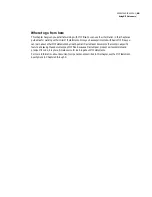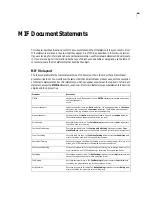
51
ADOBE FRAMEMAKER 6.0
Using MIF Statements
The variable name must be unique; case and spaces are significant. For a user variable, the variable
definition can contain only text and character formats; you can provide any character format defined in
the Character Catalog. The following example applies the default character format Emphasis to a variable:
<VariableFormat
<VariableName `Product Number'>
<VariableDef `<Emphasis\>A15-24<Default \xa6 Font\>'>
> # end of VariableFormat
You can specify character formats as building blocks; that is, the character format name must be enclosed
in angle brackets. Because of MIF parsing requirements, you must use a backslash sequence for the closing
angle bracket. You must also use hexadecimal notation for special characters in the variable definition. In
this example,
\xa6
is the hex notation for the paragraph symbol (
¶
). For more information about special
characters in strings, see page 13.
Using system variables
Whenever you open or import a MIF file, the MIF interpreter provides the default system variables. You
can redefine a system variable but you cannot provide new system variables.
System variables are defined by a
VariableFormat
statement. For example, the following statement shows
the default definition for the system variable Page Count:
<VariableFormat
<VariableName `Page Count'>
<VariableDef `<$lastpagenum\>'>
> # end of VariableFormat
System variables contain building blocks that provide certain information to a FrameMaker product.
These building blocks are preceded by a dollar sign (
$
) and can only appear in system variables. Some
system variables have restrictions on which building blocks they can contain. These restrictions are
discussed in your user’s manual and in the online Help system. You can add any text and character
formatting to any system variable.
Inserting variables
To insert a user variable or a system variable in text, use the
Variable
statement. The following example
inserts the system variable Page Count into a paragraph:
<Para
<ParaLine
<String `This document has '>
<Variable
<VariableName `Page Count'>
> # end of Variable
<String `pages.'>
> # end of ParaLine
> # end of Para
Summary of Contents for FRAMEMAKER 6.0
Page 1: ...MIF Reference Online Manual FrameMaker 6 0 Adobe ...
Page 15: ...15 ADOBE FRAMEMAKER 6 0 Introduction ...
Page 159: ...159 ADOBE FRAMEMAKER 6 0 MIF Book File Statements ...
Page 232: ...232 ADOBE FRAMEMAKER 6 0 MIF Asian Text Processing Statements ...
Page 252: ...252 ADOBE FRAMEMAKER 6 0 Examples ...






























